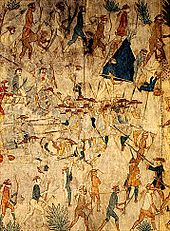Plains hide painting
Art historian Joyce Szabo writes that Plains artists were concerned "with composition, balance, symmetry, and variety.
[2] Plains Indian male artists use a system of pictographic signs, characterized by two-dimensionality, readily recognizable by other members of their tribe.
[11] Men and horses were commonly painted, and other popular motifs included footprints, hoofprints, name glyphs, bullets, and arrows.
Buckskin covers for circular rawhide hide shields, in particular, are inspired by men's visions and can include paintings of humans, animals, or spirit beings, reflecting the owner's personal powers and providing protection.
The design and related power belonged to the tipi-owner, which could be transferred by inheritance, marriage, or, among some tribes such as the Blackfeet, sale.
Arapaho and Lakota ghost dance shirts were painted with crows, magpies, turtles, and cedar trees.
In the past, Plains artists used a bone or wood stylus to paint with natural mineral and vegetable pigments.
Sections of buffalo rib could be ground to expose the marrow, which was absorbent and worked like a contemporary ink marker.
[20] In earlier times, all members of a tribe might paint but highly skilled individuals might be commissioned by others to create artwork.
[17] Before the 20th century, when a Kiowa man needed to repaint his lodge, he would invite 20-30 friends to paint the entire tipi in a single day.
On the Plains, when buffalo herds were being slaughtered in the late 19th century, other painting surfaces became available, such as muslin, paper, and canvas, giving birth to Ledger art.




